January 21, 2011
Air Date: January 21, 2011
FULL SHOW
SEGMENTS
Mountaintop Removal Mine Denied
View the page for this story
What would have been the largest mountaintop removal coal mine in West Virginia history was denied a permit by the Environmental Protection Agency. Charleston Gazette reporter Ken Ward tells host Bruce Gellerman that the agency decision isn’t the last word in the process. (05:30)
Regulations Under Review
/ Jeff YoungView the page for this story
President Obama says he wants to get rid of regulations that aren’t worth the cost. But, as Living on Earth’s Jeff Young finds out, with several major clean air rules pending, a debate rages about whether those regulations cost jobs or create them. (06:15)
Food Price Spikes
View the page for this story
The unprecedented rise in food prices around the world could foreshadow things to come in a climate-changing world. Economist Gerald Nelson of the International Food Policy Research Institute tells host Bruce Gellerman about a diet for a climate-changing planet. (05:40)
State Carbon Markets
View the page for this story
The nation’s first and only voluntary carbon trading market, the Chicago Climate Exchange, has closed its doors. But all is not gloom and doom for trading emission credits. Host Bruce Gellerman talks with Emilie Mazzacurati from Point Carbon. (06:15)
Daisy Recovery
View the page for this story
Twenty-five years ago it was thought that just seven Maguire Daisy plants existed in the whole world. Now, over 160,000 can be found living in Southern Utah. The plant was taken off the endangered species list but Tony Frates (FRAY-TUS) of the Utah Native Plant Society tells host Bruce Gellerman that maybe the flower wasn’t threatened at all. (05:50)
Menagerie on Ice
/ Jessica Ilyse KurnView the page for this story
At the SVF Foundation farm in Newport, Rhode Island, scientists harvest embryos from rare and heritage breeds, and freeze them in liquid nitrogen to safeguard them for the future. Living on Earth’s Jessica Ilyse Smith visited the farm to find how and why scientists want to preserve these animals. (06:45)
Science Note: Recycling Manure
/ Honah LilesView the page for this story
Engineers in Missouri are turning pig waste into pave roads. Honah Liles reports. (01:45)
Rewilding the World
View the page for this story
Biologists have been warning that we are in currently in a period of mass species extinction without a comprehensive plan to reverse this trend. Caroline Fraser, author of “Rewilding the World,” talks with Living On Earth’s Steve Curwood about how a modern technique called rewilding may be able to preserve the world’s biodiversity. (07:55)
Show Credits and Funders
Show Transcript
HOST: Bruce Gellerman
GUESTS: Ken Ward, Gerald Nelson, Emilie Mazzacurati, Tony Frates, Caroline Fraser
REPORTERS: Jeff Young, Jessica Ilyse Smith
NOTE: Honah Liles
GELLERMAN: From Public Radio International - this is Living on Earth. I’m Bruce Gellerman. Do environmental regulations kill or create jobs? A conservative economist tallies up the cost benefits of federal regulations.
CICCHETTI: The best stimulus we could do to the economy – in effect creating well over a million new jobs – is to get serious about environmental compliance.
GELLERMAN: Also, plans for a massive mountaintop mine get shafted by the EPA, and preserving rare animal breeds that could help cure human diseases.
BOWLEY: There’s a population of Jacob Sheep that are a perfect model for Tay-Sachs disease in people. There’s a pig breed, Ossabaw Island hog, that is a perfect model for Type 2 Diabetes in people.
GELLERMAN: We visit an unusual farm where rare herds are frozen for the future.
[RAM BLEATING]
GELLERMAN: Stories heard on the farm and more just ahead on Living on Earth. Stick around!
[THEME]
ANNOUNCER: Support for Living on Earth comes from the National Science Foundation and Stonyfield Farm.
Mountaintop Removal Mine Denied
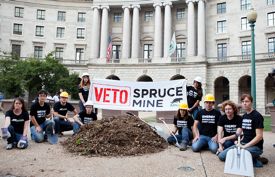
Environmental groups protested the Spruce Mine in West Virginia. (Photo: Yassine El Mansouri)
GELLERMAN: From the Jennifer and Ted Stanley Studios in Somerville, Massachusetts, this is Living on Earth. I’m Bruce Gellerman. In some places the fastest and cheapest way to extract coal is to blow the tops off of mountains, and then dig the seams exposed beneath the summits. It’s called mountaintop removal mining. The rock and rubble that’s left after the peak's been dynamited winds up in the valleys and streams below.
As you might expect the method has long been controversial. But now it’s come to a boil. In a rare move, the EPA recently denied Arch Coal permission to begin mountaintop mining at its Spruce Number 1 mine in Logan County, West Virginia. Ken Ward, a reporter for the Charleston Gazette in West Virginia, covers all things mining. He says Arch Coal had big plans for Spruce Number 1.
WARD: It’s the largest single mountaintop removal permit ever issued in the state of West Virginia. When it was originally proposed it was 3,113 acres. The new version of it, which was vetoed by the EPA, was just under 2,300 acres.
GELLERMAN: So what was EPA’s reason for denying the permit?
WARD: EPA said that the mine would have caused unacceptable damage to aquatic resources by burying something like seven miles of streams in the Pigeon Roost Hollow area of Logan County, West Virginia near the community of Blair.
There was a small bit of mining going on in that same area and EPA has been monitoring that small bit of mining that was going on under a court agreement and found that there’s already very high levels of conductivity in pollution in the streams down from where that limited mine was going on. So EPA was concerned that this mine, if it did expand, it would get even worse.
GELLERMAN: Now, I know back in 2009 EPA had warned Arch Coal that it was going to deny the permit if they didn’t make changes.
WARD: That’s correct. EPA from the start, even under the Bush Administration interestingly enough, has been very concerned about this mine. As have local citizens and statewide environmental groups and national environmental groups. The EPA has consistently raised questions about this mine and when the Obama administration came in they took those concerns to a new level and said, “We’re considering vetoing this mine using our very seldom used authority to overrule the Army Corps of Engineers decision to issue a Clean Water Act permit.”
GELLERMAN: Didn’t they make some changes?
WARD: Well they did, but this is a mining proposal that goes back to the mid to late 90’s when the mountaintop removal issue was really starting to heat up. And as a result of some litigation and EPA objections, Arch Coal did make some changes in this mining proposal, reducing its size from 3,100 acres down to about 2,300, and reducing the length of streams that would be buried. EPA said that that was not enough and EPA maintained throughout the last year or so, that there were other alternatives, and that there were things that the company could do.
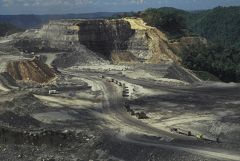
Mountaintop removal coal mine in Appalachia. (Courtesy of the Sierra Club)
And in fact, EPA paid a contractor, an engineering firm out of Kentucky -- Morgan Worldwide -- to do an analysis of the mine. And Morgan proposed a number of changes in which the company could have reduced the length of streams that they would fill by about fifty percent, at a cost of just maybe 55 cents per ton of coal mined. The company didn’t want to go along with these sorts of changes.
GELLERMAN: And now they’re not going to dig any coal from there.
WARD: Well the company hopes that it will. The company has a lawsuit filed in federal court in Washington against the EPA, challenging EPA’s authority to step in and try to veto this permit. Now that EPA has finalized its veto decision, what we’ll probably see that case start to heat up.
GELLERMAN: So here the Army Corps of Engineers signs off on it, says, “Okay, let ‘em go,” and the EPA turns around and says, “No, no no!” It sounds like they’re mis-communicating.
WARD: Well I don’t know if it’s miscommunication as much as maybe a different way of looking at things. And, you know, the Corps of Engineers has a long history of approving these sorts of permits and their actions have been criticized by federal judges and others that they’re going too easy on these companies and issuing permits that don’t properly consider the potential environmental impacts.

Environmental groups protested the Spruce Mine in West Virginia. (Photo: Yassine El Mansouri)
And Congress, when it wrote the Clean Water Act decided that perhaps just for these reasons that the EPA should have some oversight and really EPA should have the final say on issuing of Clean Water Act permits.
So that’s what EPA has done here -- stepped in on a rare occasion for thousands and thousands of permits that are issued every year under the Clean Water Act, this is only the thirteenth time that EPA has ever stepped in to veto a permit. It’s the first time that they’ve actually vetoed a permit that had already been issued by the court.
GELLERMAN: So, implications for other mountaintop removal projects that are in the works?
WARD: Well, we don’t know because at about the same time that the EPA was announcing that it was going to veto the Spruce mine, a federal judge in Washington in a somewhat related case ruled that the National Mining Association might have a point when it argues that some of EPA’s efforts to rein in mountaintop removal have been done contrary to law, by EPA issuing guidance documents and things like that without first allowing public input on those documents. The judge in that case didn’t issue an injunction against EPA, but did indicate that he thought that perhaps EPA might lose on the merits of the case. We’ll have to see what happens with that.
GELLERMAN: Well Ken, it’s always good talking with you.
WARD: Good talking to you, thanks for having me.
GELLERMAN: Ken Ward is a reporter for the Charleston Gazette in West Virginia.
Related links:
- Ken Ward’s Blog Coal Tattoo
- Arch Coal
[MUSIC: Jorma Kaukonen “Hamar Promanade” from Quah (BMG Heritage 2003).]
Regulations Under Review
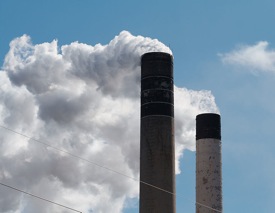
(Photo: Dori Wiki Commons)
GELLERMAN: President Obama’s byline recently appeared in an unlikely place: the opinion page of the Wall Street Journal. The President wrote about his new executive order calling for a review of regulations to make sure they’re cost effective. The Journal’s editorial writers frequently attack the Obama administration for proposing what they call onerous and job-killing regulations.
But as Living on Earth’s Jeff Young reports, the economic impact of those regulations is subject to debate. In fact, some analysts say tougher rules could create more jobs.
YOUNG: The President’s executive order calls for a government-wide review of rules on the books and a common sense approach to new rule making. In his Wall Street Journal opinion piece the President writes the mission will be to, quote, “root out regulations that conflict, that are not worth the cost, or that are just plain dumb.”

The target audience -- the business community -- responded with polite and hopeful statements. The US chamber of commerce called it a “nice first step” but then called for more “fundamental reform of our broken regulatory system.” The President drew a harsh response from some progressive and environmental groups.
STEINZOR: I found it very disappointing.
YOUNG: That’s University of Maryland law professor Rena Steinzor, president of the Center for Progressive Reform. Steinzor ticked off reasons she thinks the President sent the wrong message.
STEINZOR: Well, we all watched with horror the spill in the Gulf of Mexico, which was preceded by a fireball that killed 11 people, collapsing mines killing 29 people, cadmium in Shreck glasses, salmonella in peanut butter. I don’t think over-regulation is the problem; it’s under-regulation.
YOUNG: Steinzor worries what a new stance on regulations might mean for pending decisions on public health and safety. That’s a concern shared by Frank O’Donnell at Clean Air Watch, an environmental watchdog.
O’Donnell says EPA has already recently postponed final rules on toxic emissions from industrial boilers and smog-causing ozone. And deadlines are approaching on rules for mercury emissions, soot and the downwind drift of pollution.
ODONNELL: The White House and the EPA are going to be looking over several very, very major standards that will determine the course of clean air in this country for a long time to come. And the White House is going to have to let the EPA do the right thing here or else it’s going to lose a lot of credibility.
YOUNG: O’Donnell says the President’s regulatory review could embolden EPA critics, like the conservative Heritage Foundation. That’s where James Gattuso studies the costs of government regulation. He finds the President’s remarks refreshing.
GATTTUSO: I think it is a shift in tone. It is certainly a recognition by the President that there is a lot of a concern around the country that regulation has gone too far.
YOUNG: Gattuso added up the estimated cost of new regulations from the last fiscal year--including greenhouse gas proposals and fuel economy standards for cars and trucks. It totaled nearly 28 billion dollars—a cost Gattuso says will translate into fewer jobs.
GATTUSO: If you impose costs on businesses, if you impose costs on entrepreneurs, they will respond by, well, certainly not grow as fast, not hire as many people. In long run I think the effect will be lower paying jobs and less prosperity.
YOUNG: To illustrate the point, Heritage produced this spoof video, in the style of an old educational filmstrip:
ANNOUNCER: Hey there, Jimmy! So you want to learn how to kill jobs and burden the economy with onerous regulation?
JIMMY CHARACTER: Wait, what? No, those do not sound…
ANNOUNCER: Great! Let’s get started!
YOUNG: The talking point “job killing regulation” has become a sort of mantra whenever environmental rules come up. It’s heard in Capitol Hill press conferences:
GRAHAM: (Sen. Lindsey Graham, R, SC) Putting a regulatory burden on American businesses now would be a job killer.
YOUNG: On talk radio:
INHOFE: (Sen. James Inhofe, R, OK) Now, with the Obama administration in, they are just regulating us out of jobs in America.
YOUNG: And on Fox news:
FOX NEWS REPORTER SHANNON BREAM: It’s the administration, primarily through the Environmental Protection Agency, that’s killing jobs.
YOUNG: Those critics point to economic forecasts of dwindling jobs as regulations pile up. But many economic analyses of the environmental proposals in question do not show widespread job losses.

(Photo: Dori Wiki Commons)
CICCHETTI: It’s a popular belief. It turns out that, like some popular beliefs, this one is wrong.
YOUNG: That’s economics professor Charles Cicchetti. He’s studied the issue for four decades, most recently at the University of Southern California. Cicchetti’s latest work looks at the proposed clean air transport rule. It would limit pollution from power plants and refineries that harms health in downwind states.
Cicchetti found that pollution costs downwind businesses some 5 billion dollars in lost workdays and lower productivity. But the real eye opener is the job impact. Cicchetti says the rule won’t kill jobs—it will create them.
CICCHETTI: The best stimulus we could do to the economy, in effect creating well over a million new jobs, is to get serious about environmental compliance. It’s just the opposite of the argument that we can’t afford to do anything about the environment when the economy is tough.
Now’s the time to do it because we have unemployment, particularly in the construction industry, we have unemployment in many of the areas where these electric power plants and refineries are located and that would need to employ people to bring about those improvements.
YOUNG: Now, Cicchetti doesn’t dispute that cleaning the air will be expensive. This rule could cost 3 billion or more a year. But he says the affected companies—large electric utilities and oil refiners—can afford it. Many have reported record profits while delaying necessary investments in pollution controls. And if you’re dismissing this study as the product of just another liberal think tank, think again.
CICCHETTI: I am a conservative Republican. In fact, when I was at USC I was faculty advisor to the campus Republicans.
YOUNG: Studies like Cicchetti’s challenge the conventional wisdom about job killing environmental regulation. The coming months could determine which view prevails. For Living on Earth, I’m Jeff Young.
Related links:
- **Web extra interview: Dr. Robert Pollin, co-director of the Political Economy Research Institute at UMass Amherst, talks to Jeff Young**
- Executive Order on regulatory review
- Prof. Cicchetti’s study on economic impacts of a clean air transport rule
- Heritage Foundation on costs of regulation
GELLERMAN: Just ahead – a rare daisy: It’s endangered... it’s endangered not... it’s endangered… it’s endangered not… keep listening to Living on Earth!
[MUSIC: Freddie Hubbard: “Red Clay” from Red Clay [MUSIC: The SoulJazz Orchestra “Mugambi” from Freedom No Go Die (Fink Manchu Records 2006).]
Food Price Spikes
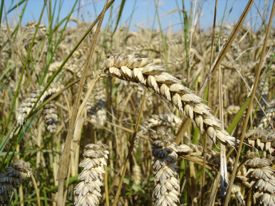
Wheat plant. (Photo: Wiki Commons)
GELLERMAN: It’s Living on Earth, I’m Bruce Gellerman. Call it a diet for a climate-changing planet. In the future we’ll be eating more potatoes, beans and lentils, and less meat and animal products. And we’ll be paying a lot more. That prediction is in a new report from UN scientists.
But we’re already getting a glimpse of things to come, as costs rise and food grows scarcer. Recently there have been food riots and demonstrations in several North African countries. Gerald Nelson is an agricultural economist and senior research fellow at the International Food Policy Research Institute.
NELSON: We’re currently, as of Jan 2011, looking at price levels that are about the same as they were in at the peak in 2008. And 2008 was a year that we saw a few governments change and food riots in the streets of several countries. The thing that makes the spikes particularly bad from an insecurity perspective is the sudden change.
You know, if things change gradually, we can adapt, we can find ways to try different systems. But if all of a sudden the prices go from, you know, a dollar for a loaf of bread to two dollars for a loaf of bread and your monthly income is only ten dollars, you’re in real trouble in terms of being able to feed yourself and feed your family. So it’s these sudden shifts in prices that cause the political unrest that we’ve seen in the past, 2008, and while I hope we don’t see it in 2011, it’s certainly a possibility.
GELLERMAN: So, why is the price of food going up these days?
NELSON: Well a variety of reasons. But for the most part, the drivers of the high prices at the moment are various kinds of weather-related shocks. The Russian drought and high temperatures of last summer, the floods in Bangladesh, the floods in Australia, all of these are causing wheat prices to go up.
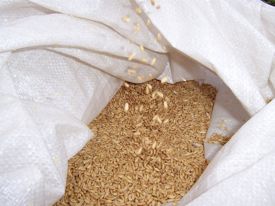
There is a shortage of harvested wheat like this around the world. (Photo: Wiki Commons)
In the United States, the USDA just released a new report that suggests that the grain stocks in the US are shorter than expected caused partly by weather. And there are some other weather-related phenomena around the world that are causing various markets to spike upward and likely to continue to go up, I think.
GELLERMAN: Well, weather comes and goes. What about this wildcard of climate change? How does that affect our agriculture?
NELSON: Well we’re not to the point where we can say these particular things we’re seeing right now, or that we saw in 2008, can be attributable directly to climate change. But we can expect to see more of these kinds of events in the future. And so I think we should look forward to a future with more of these price spikes and more uncertainty about what’s going to happen to the availability of food in any particular year.
GELLERMAN: This stuff has deep and widespread national security implications.
NELSON: Indeed! I was at a meeting yesterday where some of the members of the National Security Agency of the United States were asking questions about, well, what does this really mean for our United States national security? Not to mention threats to the rest of the world.
Obviously the short answer is it’s a complicated question and we don’t know. But we’ve seen governments lose their power as a result of food price spikes in the past, and if some of the dire predictions on the consequences of climate change, for example in sub-Saharan Africa take place, then we could see substantial, for example, migration events happening. A lot more climate migrants than we currently have environmental migrants. And the risk of domestic strife in those countries, plus spilling over into the rest of the world, is something that intelligence agencies are already concerned about.
I am cautiously optimistic that we can deal with the challenges coming by 2050. But if we get beyond 2050 and we haven’t dealt with greenhouse gas emissions, then I’m really worried.
GELLERMAN: The two drivers that people are looking at towards the year 2050 are: Population increases -- there are more mouths to feed, I guess nine billion people by 2050. And then income growth -- people are going to be making more money and they’re going to want to eat higher on the hog.

The United Nations World Food Programme transports food aid around the world to feed people in countries where there are extreme food shortages. (Photo: Wiki Commons)
NELSON: Yeah, that’s right. And add to that fact that most of the increase in population is going to take place in what we call the developing countries today. But much of the income increase also takes place in those locations. So you have kind of a double whammy from the population and income growth in particular parts of the world. And with great uncertainty it still seems likely that those places are going to be the places that will suffer more from climate change than what we call the developed countries today.
GELLERMAN: And these are places where they haven’t contributed that much to climate change.
NELSON: That’s correct. Those countries have very low emissions and so in some sense they haven’t contributed to the problem that we have today. But, it’s also the case that as they grow and their agriculture sectors are expected to produce more food, if they adopt the same practices that we’re using in the north in the rich countries of today, then there will be a lot more greenhouse gas emissions.
And so they need to think about being carbon negative in their agricultural sectors. That is, not only reducing and eliminating their greenhouse gas emissions from agriculture, but actually taking carbon dioxide out of the atmosphere and putting it into the ground, increasing the soil carbon. We’re not there yet in terms of saying this, “We have the magic bullet or set of magic bullets,” but I think we’re going to have to find them if we’re going to deal with global warming.
GELLERMAN: We’ve been taking with Gerald Nelson. He’s an agricultural economist and senior research fellow at the International Food Policy Research Institute in Washington DC. Mr. Nelson, thank you.
NELSON: Thank you.
[MUSIC: Booker T & The MG’s “Red Beans And Rice” from The Best Of Booker T & The MG’s (Atlantic Records 2004)]
State Carbon Markets

Emilie Mazzacurati (Photo: Emilie Mazzacurati)
GELLERMAN: Officials halted online trading of carbon emissions credits in Europe after discovering millions of dollars worth of permits had disappeared. The cyber attacks were detected in accounts in Greece, Austria, Poland and Estonia. But here in the U.S we have problems of our own.
On December 31st trading in carbon credits was halted… permanently. The nation’s first and only voluntary carbon trading market has gone the way of the dodo. The Chicago Climate Exchange offered companies the chance to buy and sell greenhouse gas emission credits, so they could voluntarily reduce their carbon footprint. With the exchange gone, we turn to Emilie Mazzacurati. She’s head of research in North America for The Thomson Reuter company Point Carbon.
MAZZACURATI: The Chicago Climate Exchange was a very peculiar system in that it was a voluntary program, a sort of a club, for private companies who wanted to get a heads up and start practicing what it would be like for them to be in a cap and trade program. And so it was set up to start in 2006 and finish in 2010. So the question that managers and the directors of the company were facing right now is, should we renew the program or has the program reached its goal, and reached the natural end?
And, over the past couple of months, if not years, as the debate really shifted from voluntary to having federal regulation or having states implement their own cap and trade program, the market itself had seen a big drop in activity, a big drop in prices, and therefore it seemed like a natural end to just wrap up the program.
GELLERMAN: You had some really big companies involved in the exchange: Motorola, Ford, IBM, Dupont. Why would a company put real money on the table for something that they didn’t have to buy and sell?
MAZZACURATI: Well, so, there are several reasons why companies would do that. The first one, I think is worth mentioning, is understanding how the market works and getting their systems set up internally, growing their expertise internally, so that it would be ready to manage a real exposure in a real market when it comes down the line. And that’s worth a lot of money, so that’s worth investing into. Then of course there’s the value in terms of being an early mover in terms of corporate social responsibility--showing you are actually reducing your emissions, even when you are not being forced to, and that you could score points with the public and with shareholders.

Emilie Mazzacurati (Photo: Emilie Mazzacurati)
GELLERMAN: So you have at least a temporary demise of the Chicago Climate Exchange, and the EPA recently announced that its Climate Leaders Program, which was also a voluntary program to have companies announce their emissions and work towards lowering them, it was eliminating that. Are companies just giving up?
MAZZACURATI: I actually think there are very different things going on here and that it may not be the bad news that you think it is at first. The Chicago Climate Exchange played its role in pioneering cap and trade in the United States, and the next natural thing to happen, happened, which is regulators picked it up and moved on and appropriated the idea and have developed it into their own compliance program.
When it comes to the EPA, they’re rolling out their mandatory reporting greenhouse gas program. That’s going to start this year, which means starting March or April 2011, we’ll have very comprehensive emission data by facility, by company, across the United States for the first time ever. And this is going to replace the voluntary reporting of emissions that was the program that they recently shut down.
GELLERMAN: So a lot of states have cap and trade programs; the federal government doesn’t.
MAZZACURATI: Yes there is a lot of activity right now at the state level in particular. At the federal level I think we all know that the prospects for climate regulation in the coming two years are not exactly very good, but in California, in Oregon and Washington, in the northeastern states, there’s a lot of work being done to establish or continue running carbon markets.
So the role of the CCX which was to be sort of a pioneer and nudge states and regulators towards having their own programs has been fulfilled, has been achieved, they’ve reached their goal in a way. There is a carbon market in the Northeast. There’s going to be a carbon market in California in just a year from now, and there isn’t necessarily a need for a voluntary program anymore.
GELLERMAN: Those northeast states that you talked about they’re called RGGI, am I right?
MAZZACURATI: Correct.
GELLERMAN: The Regional Greenhouse Gas Initiative? And the one in California is interesting because it’s going to be trading with Canada, which means you have a state doing international carbon trading.
MAZZACURATI: Precisely! And what’s interesting with California too is that they’re very ambitious. They’re very aggressive, they’re a very large state as you know, they’re bigger than many countries in the world, so their doing this is very significant. And it’s significant not only because you will reduce emissions, because it will and it is building those bridges with Canada, with the early movers in Canada and setting up the system for those companies to reduce emissions at the lowest cost.
But it’s also going to force the debate to remain active and to remain on the table at the federal level because companies will be regulated one way in California, regulated another way in New York state, and maybe not regulated in a third state. At some point there is going to be a need again for a federal policy that sort of harmonizes this.
GELLERMAN: So, the federal government whether it politically likes it or not is going to be forced into a carbon market, do you think?
MAZZACURATI: I think eventually we’ll come around and do something on climate, not just because companies will request and will prefer to have a standard federal policy rather than a patchwork of policies across states, but also because I think at some point the physical reality of climate change is going to catch up with us.
It’s not looking good right now, but politics change really fast. You don’t know where you’re going to be in two years. There’s going to be a new presidential campaign, there’s going to be a new Congress, it could very well be picked up in just a few years from now, and essentially that means that we’d come back to having a discussion on cap and trade and market mechanisms by 2012, 2013.
GELLERMAN: I’ve been talking to Emilie Mazzacurati. She’s head of carbon research in North America at Point Carbon, it’s a Thomson Reuters company, thank you very much, Ms. Mazzacurati!
MAZZACURATI: Of course, thank you for having me!
Related links:
- Regional Greenhouse Gas Initiatives website
- Point Carbon
[MUSIC: Easy All-Stars “Time” from Dub Side Of The Moon (Easy Star Records 2003).]
Daisy Recovery

The Maguire Daisy (Erigeron maguirei) lives only on cliffs in Southern Utah (US Forest Service)
GELLERMAN: Twenty-five years ago it was believed there were just seven Maguire daisy plants in the world. And they were only found in three counties in southern Utah. But now thanks to some creative conservation efforts, the dime-sized daisy, a member of the sunflower family, faces a brighter future.
The US Fish and Wildlife Service has just taken the plant off the endangered species list. Tony Frates is conservation co-chair of the Utah Native Plant Society. Good news, huh Mr. Frates?
FRATES: Well it is good news, and it shows, I think, that the Endangered Species Act does take new information into account and decisions are made accordingly and things that are no longer eligible to be listed should be taken off the Act when they’re found to be more abundant than was originally thought.
GELLERMAN: What does it look like?
FRATES: If you think of a typical composite, or a daisy-type flower, it’s a… it has white ray flowers, it has a yellow center, it has some other coloration. It’s a low plant; it’s not a really tall plant. It has some typical erigeron daisy-like characteristics.
GELLERMAN: So, it’s one of those she-loves-me, she-loves-me-not daisies?
FRATES: (Laughs) Well, we would hope people would not pick those rays, but it’s a little different in terms of how its flower is shaped and what it looks like. But you could think of it that way.
GELLERMAN: Mr. Frates, um, do you know who Maguire was? Maguire daisies, the name, so who’s Maguire?
FRATES: Yes. It was named for Bassett Maguire who was well-respected botany professor from Utah State University. Whether it was named in his honor because of all of his botanical contributions to Utah, which was great, or whether he actually did collect it and it was named for that reason, I’m not certain. But that’s who it was named in honor of.
GELLERMAN: Well, what happened to the Maguire daisy? What was the threat?
FRATES: The main threats have been mining. It grows on cliffs. It also can grow though out on more exposed area and so there’s some threat from cattle grazing. Part of it was that its ecology really wasn’t understood initially. This is pretty much a typical story for something that’s as rare as this. Until people get out and look at it, there’s kind of a Catch-22, because people aren’t going to go out there and look for it until it has some kind of a status. And at first it wasn’t realized where it grew exactly, and I think once they figured out more what kind of habitat it truly grew in, that’s when they started to find more of them.
GELLERMAN: So, now we have how many of these daisy plants?
FRATES: Now it’s thought that there are over 160,000 plants occurring in some 10 different populations that are more or less contiguous to one another. So they’ve been occurring in some of those meta-populations. So, the numbers have regularly risen. If someone were to say, “let’s list this species” and it has 160,00 members, if they all occurred in the same couple of acres or few miles, you might still want to list that because its habitat would still be possibly imperiled by some natural catastrophe.
But with that kind of number and given the number of occurrences, you know, a species today in that condition would not get on the Endangered Species Act and so it’s appropriate to review that information and say, “hey, this should probably be de-listed.”
GELLERMAN: So, it’s on the road to recovery!
FRATES: Well, it should come off the Endangered Species Act because it now is known to have had a much larger occurrence than was thought. But, it has always probably had that number of plants. It’s very difficult to know, sometimes, how many plants there are in a given area because plants can fluctuate tremendously from year to year in a given area, in terms of whether they even flower. We’ve had years of drought in the West, for example, in the last ten years, where people have gone out to look for plants and they’re not flowering or they can’t find them very easily.

The Maguire Daisy (Erigeron maguirei) lives only on cliffs in Southern Utah (US Forest Service)
And then you go out another year and you can find more. And so it would be very difficult to determine whether a plant had become extinct for that very reason. So it has recovered only in the sense that we have additional information that it should come off the Endangered Species Act.
GELLERMAN: So you’re saying there weren’t seven Maguire daisies back then, and we just didn’t know where these other ones were?
FRATES: Exactly.
GELLERMAN: So, we just found these things.
FRATES: Correct. The argument is that the Endangered Species Act gave this species some attention which led to a separate group finding more. But it was difficult and it took many years of work and so, based on the best available information, we thought there were fewer and now we know that there are a lot more.
GELLERMAN: So, this is not the success story we might have thought.
FRATES: Well, it’s a story that has a happy ending. But it’s not -- to say that it has recovered only is like I said, to say that we have more information to indicate that it actually wasn’t as rare as we thought it was. And that is not an uncommon story.
GELLERMAN: Are there other plants that this might apply to in Utah?
FRATES: Probably in every case. I mean when everything is listed, usually the numbers always increase by some amount. But agencies don’t have the resources, and botanists typically get hired based on the status of things, and that’s where we’re in this Catch-22 where we need a candidate species program, or a sub-tier program that can identify things that do get some attention so that we can determine if they’re truly worthy of listing.
GELLERMAN: Well, Mr. Frates thank you very much. I really appreciate it.
FRATES: My pleasure.
GELLERMAN: Tony Frates is Conservation co-chair of the Utah Native Plants Society.
[MUSIC: Various Artists/The Defenders “Daisy” from Guitar Mania 23 (Sam Sam Music/The Orchard 2010).]
GELLERMAN: Just ahead – How ya gonna keep ‘em down on the farm – after they’ve gone extinct? For an answer, stay tuned to Living on Earth!
ANNOUNCER: Support for the environmental health desk at Living On Earth comes from the Cedar Tree Foundation. Support also comes from the Richard and Rhoda Goldman Fund for coverage of population and the environment. And from Gilman Ordway for coverage of conservation and environmental change. This is Living On Earth from PRI, Public Radio International.
Related links:
- The US Fish and Wildlife Service on the Maguire Daisy
- Utah Native Plant Society
[MUSIC: Martin Barre: Winter Snowscape” from Stage Left (Fuel 2000 Records 2006).]
Menagerie on Ice

Arapawa Bucks. (SVF Foundation)
GELLERMAN: It’s Living on Earth, I’m Bruce Gellerman. There’s an unusual sign at the entrance to a farm in Newport, Rhode Island warning the public is not welcome. It reads: “Biosecure area. Absolutely no trespassing. Please leave immediately.” But Living on Earth’s Jessica Ilyse Smith got into the off-limits farm and reports from behind the closed gate.
[WIND, ANIMAL NOISES IN BACKGROUND]
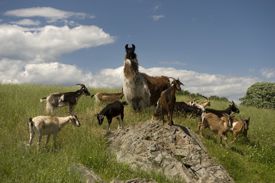
The guard llama protects the farm’s oddball menagerie. (SVF Foundation)
SMITH: A stately llama stands guard atop a hill. He’s protecting an unusual herd of goats and sheep from lurking coyotes. Among them are hairless faced Gulf Coast Sheep, Hog Island Sheep with curled horns, and Tennessee Fainting Goats—an apt name since when startled they stiffen and fall to the ground. These aren’t ordinary barnyard beasts; these animals are all heritage breeds. Sarah Bowley, the livestock manager for the SVF Foundation, says the organization’s mission is to protect these oddball animals from extinction.
BOWLEY: We focus on critically endangered breeds that are based in North America that were important to the founding fathers when they started the country.

Hog Island Sheep. (SVF Foundation)
SMITH: It’s a sunny day, and a crisp breeze rolls in from the Atlantic Ocean, barely a mile away. Bowley takes me to visit the farm’s newborn goats.
[METAL DOORS OPENING]
BOWLEY: Kids, c’mon kids.
[GOAT SOUNDS]
BOWLEY: Baby goats are just so much fun. You know, compared to the other species they can just be so entertaining to watch.
SMITH: A bold kid named Rob comes up and sniffs my microphone.
[GOAT SNIFFING MICROPHONE]
SMITH: Rob is an Arapawa goat with shaggy fur on his legs and a badger-like striped coat. Bowley explains just how extra-ordinary he is.
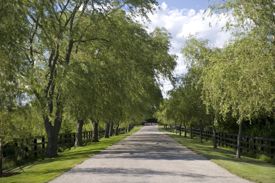
The long path into the farm. (SVF Foundation)
BOWLEY: We had these two kids born about a month ago and they’re embryo transfers that were collected and frozen last season and then this spring we thawed them out and implanted them into their two surrogate moms and they were born about a month ago.
SMITH: Rob was a frozen embryo because Arapawa Goats are critically endangered. In the last census two years ago the Arapawa Goat Breeders USA found a population of just 318 individuals worldwide. Bowley says these animals are worth saving, not only for their friendly personalities, but also for their disease resistance—a trait that could come in handy in the future if illness strikes more popular goat breeds.
[ANIMALS AND BARN SOUNDS]
BOWLEY: Hi mamas.
SMITH: Part of the process of saving these endangered species is using a more common breed as a surrogate mother. In this case, Rob’s mother was a common dairy goat, a Saanen.
[GOAT SOUNDS]
SMITH: This energetic kid is the product of a highly scientific lab procedure not unlike human in vitro fertilization. Embryos are harvested from pregnant female goats and brought to the lab to be frozen.

Arapawa Bucks. (SVF Foundation)
[DOOR OPENING, WALKING]
SMITH: Bowley and I head out of the barn and go to the lab where the scientific process happens. Dr. Dorothy Roof, the lab supervisor, greets us at the door and shows us around.
ROOF: In a way, how the lab is laid out tells you the process of what we do.
SMITH: The lab has three rooms. In the first room Dr. Roof places the embryos into a special freezer that steps down the temperature ½ a degree a minute until they reach minus 35 degrees Celsius. Once they’re frozen, she plunges the embryos into liquid Nitrogen to preserve them.

This bridge on the grounds illustrates the SVF Foundation’s motto, “A Bridge to the Future for Heritage Breds.” (SVF Foundation)
ROOF: Once they’re in liquid nitrogen, as long as they stay in liquid nitrogen, the estimates of how long they survive: hundreds of years.
SMITH: This is important, as scientists predicts large biodiversity losses in the next few centuries. We move into the next room where tissue biopsies and serum samples are collected from each embryo.
ROOF: The serum will contain all of the antibodies that the animal has in its blood. So in a way it’s a running readout of all of the pathogens that they’ve been exposed to during their lifetime.
SMITH: In the final lab sit four massive, stainless steel tanks. Each tank is filled with about four feet of liquid nitrogen—they act as a large insulated thermoses for the embryos. Roof opens up the tanks.
[SOUND OF TANK OPENING]
SMITH: And vapors billow out.

Scientists look at animal embryos. (SVF Foundation)
ROOF: It’s always the picture that everyone wants to take when they come here—the liquid nitrogen vapors. It is pretty spectacular.
SMITH: But all you can see is the vapor. So Dr. Roof sucks it off with a hose.
[VACCUM HOSE SOUNDS]
SMITH: Inside the tanks there are tiny red straws filled with embryos, each labeled with information about its biological parents. The whole process is closely monitored to make sure that the embryos will be viable for hundreds of years.

A row of cryogenic tanks, where the embryos are frozen. (SVF Foundation)
ROOF: It’s kind of reverse archeology. I try to think to myself what it would be like for me 100 years from now looking back at the person who made these embryos into the tank. I also think about what would happen if it were really like an archeological dig and all of the records were lost.
SMITH: Right now the SVF Foundation is focusing on 25 critically endangered breeds of goats, sheep and cattle, their goal is to freeze 300 embryos of each breed.
[SOUNDS WALKING FROM THE LAB]
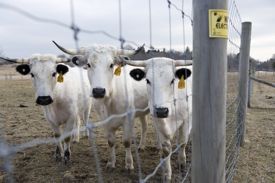
Critically endangered Ancient White Park cows. (SVF Foundation)
SMITH: As Sarah Bowley and I leave the lab she talks about the loss of animal diversity. Livestock breeds are going extinct at a rate of about one per month. Saving them is important, she says, because many of these animals can act as scientific models for human diseases.
BOWLEY: For example there’s a population of Jacob Sheep that are a perfect model for Tay-Sachs disease in people. There’s a pig breed, Ossabaw Island Hog, that is a perfect model for Type 2 Diabetes in people.
SMITH: Also, Bowley says keeping these embryos around might one day solve a global problem.
BOWLEY: So, if there’s a disease outbreak or a certain texture or flavor of meat that’s desired or any other genetic combination that these animals can solve, we want to have their genetics available, even in just a frozen form, so that they can be reawakened and brought back hundreds of years from now.
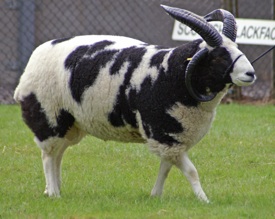
Jacob Sheep. (Photo: Wiki Commons)
SMITH: For now the embryos slumber in their deep freeze, and wait until they’re called upon to resolve some crisis. And who knows, in the future the fate of the human food supply might just be resting on their horns. For Living on Earth I’m Jessica Ilyse Smith in Newport, Rhode Island.
Related links:
- Learn more about the SVF Foundation and take a look at the different animals on the farm.
- A Bridge to the Future for Heritage Breeds
[MUSIC: Eri Yamamoto “Sheep Song” from In Each Day, Something Good (AUM Fidelity Records 2010)]
Science Note: Recycling Manure
GELLERMAN: Just ahead – nature gone wild thanks to scientists. But first, this note on emerging science from Honah Liles.
[SCIENCE NOTE THEME]
LILES: Pigs are about to hit the road, or at least, their waste is. Engineers at the St. Louis design firm Innoventor have created a device that converts pig waste into something useful: bio oil. The system works like a pressure cooker: The pig waste slurry is pumped from the pits under the barn, heated and pressurized.
This turns the solids into bio oil, leaving a byproduct called black water. The black water and bio oil are separated as they leave the reactor. The engineers say that because this black water retains nutrients from the waste, it could potentially be used as a fertilizer. The bio oil is also useful. It might become an energy source, and already it is being used as an asphalt-binder.
It’s currently being tested on a stretch of road outside St. Louis, Missouri. Both Innoventor and the Missouri Department of Transportation plan to monitor the condition of the road over the winter, to see if the bio oil binder can stand up to a season of freezing and thawing. The bio oil conversion process is quick, so a 10,000-hog farm could produce about 10 to 15 barrels each day. That could generate revenue for the farmers, as well as deal with an environmental problem. Because the pig waste is pumped directly to the converter, it eliminates the need for smelly manure lagoons.
If the waste-derived asphalt holds up over the winter, little piggies could soon be heading to market on a road they helped pave. That’s this week’s Note on Emerging Science. I’m Honah Liles.
Related links:
- Manure Manager Magazine article
- Innoventor’s info page
Rewilding the World
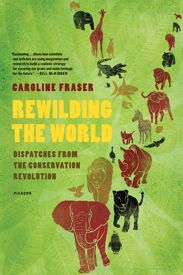
GELLERMAN: The statistics on environmental destruction make for some gloomy reading: Species are currently disappearing a thousand times faster than before humans showed up. Nearly a quarter of all mammals are under threat – a third of all invertebrates, 70 percent of all plants. But there’s a breed of scientists and conservationists who are trying to undo the damage. Caroline Fraser chronicles their efforts in her new book “Rewilding the World.” Fraser recently spoke with Living on Earth’s Steve Curwood.
FRASER: Most of our protected areas are just way too small to protect the species within them. What we’ve done, is create these little islands of habitat which we call parks. But what we’re finding out about genetics and the needs of species in wilderness was that many critical species really need huge amounts of habitat compared to what we had set aside for them. And so Rewilding is now a method of creating much larger wilderness areas.
CURWOOD: So, when I read Rewilding, I see three words together: cores, corridors and carnivores… and that means?
FRASER: Those are the three elements that make up most rewilding projects. And the cores are these big wilderness areas that we need. The idea of cores is not really all that new, but the idea of the scale of those core areas that we need was quite new. And we also discovered that we needed to restore connections between these wilderness areas. Many of them are just too remote, too fragmented and isolated from each other, and so they’re functioning almost as islands.
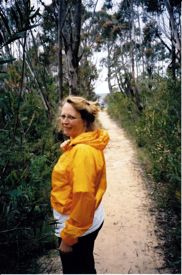
Author Caroline Fraser. (Photo: Hal Espen)
And what biologists have learned about islands is that the smaller the island, the fewer species it can maintain. So we have cores, big core wilderness areas, we need corridors to connect them, or reconnect them, and we need, we’ve increasingly found carnivores, the big top predators, which actually serve to regulate ecosystems.
CURWOOD: Tell me, how is it that large carnivores are so important for rewilding?
FRASER: Well, what biologists have found is that top carnivores function to regulate the ecosystem. They control not only prey species, but also smaller predators. Michael Soulé, who is really the father of conservation biology, was quite critical in observing this. And he was observing, in his case coyotes in the chaparral ecosystems around San Diego.
If you take the coyotes out, smaller predators go hog wild. And the small predators that were doing this around San Diego were actually housecats, which were killing many different species of birds, particularly the ones that nest and feed on the ground. So, the presence of coyotes, actually acted to increase the number of birds because the coyotes were controlling the cats.
CURWOOD: How can we protect large swaths of land for wildlife, but also accommodate human needs?
FRASER: Well, that’s really the fourth “C” that they did not envision, communities. The idea is to try to create sources of income, especially through ecotourism, through guiding, and even in some case through the issuing of hunting licenses. These can be enormous sources of revenue, which can then be funneled back into communities, which encourages then local people to stay with these projects.
CURWOOD: Now, in a place like Africa, the top predators aren’t terribly popular. I’m not thinking so much of lions -- they rarely go after people. But crocodiles regularly will lie along riverbanks waiting for somebody to come for a swim or something and it’s a pretty strong ethic in Africa where “the only good crocodile is a dead one!” How do you deal with that?
FRASER: That’s an incredibly difficult issue, as I discovered. In the Okavango Delta where I spent some time with biologists who were working on a project that was designed, not only to learn about the biology of the crocodile, but they also were trying to figure out ways to convince local people to live with this very scary predator. They have finally, I think, made some progress by developing a crocodile farm that yields significant amount of revenue locally, as a way of proving that this species has a dollar value.
CURWOOD: So, describe for us the importance of the crocodile in that ecosystem.
FRASER: Well, what they’ve found is with the disappearance of many of the large crocodiles in the Okavango Delta, is that, the prey species, which in this case happens to be catfish, have really grown out of control. And that’s been really bad for many local businesses, which are based on sport fishing of other species of fish. And so what they need to do is reestablish their balance between the predator and the prey. And what that’s going to take is convincing people not to burn areas where crocodiles have their nests, not to destroy the nests and the eggs, but to allow the natural balance to reassert itself.
CURWOOD: Costa Rica has a reputation as having done extremely well in bringing back its natural environment, and really advancing conservation there. How true is that reputation, and how did they achieve it, if you do agree it has a great reputation?

FRASER: Well it does have a great reputation, in part because Costa Rica recognized so early on the value of the rainforests and the other ecosystems that it has. It’s a mixed picture however because they haven’t had enough money to invest in park rangers and protection. So Costa Rica, like many developing countries has a big problem with poaching in certain areas. But they really are an extraordinary example for the world, because they have now set aside about 25 percent of their country in protected areas. And now the push is on in finding the money to really invest in protecting these places.
CURWOOD: And what are the consequences if these projects don’t work?
FRASER: Well, the consequences are an exacerbation of what we see happening. We’re in a mass extinction event, which is being called the sixth great extinction, in which we’re seeing extinction rates skyrocket from 100 to 1,000 times the normal background rate of extinction, which is just a few species per decade. Many people are not aware of how much we rely on species that are coming out of the tropics, and for marine ecosystems. About half of the worldwide pharmaceutical market is coming from things that are derived from marine organisms. So, when we destroy these ecosystems, we’re really destroying an enormous bank of products and things that we rely on.
CURWOOD: Caroline Fraser’s book is called, “Rewilding the World: Dispatches from the Conservation Revolution.”
GELLERMAN: That’s Living on Earth’s Steve Curwood with author Caroline Fraser.
Related links:
- Learn more about Rewilding the World
- Visit Caroline Fraser’s blog
[MUSIC: Pat Metheny “Spirit Of The Air” from Orchestrion (Nonesuch Records 2010)]
GELLERMAN: On the next Living on Earth, we address the state of the environment in the State of the Union. Deficit reduction and deregulation versus green energy and conservation. Can the President square the circle with a changed Congress? Next time, on Living on Earth.
Living on Earth is produced by the World Media Foundation. Our crew includes Bobby Bascomb, Eileen Bolinsky, Ingrid Lobet, Helen Palmer, Jessica Ilyse Smith, Ike Sriskandarajah, Mitra Taj, and Jeff Young, with help from Sarah Calkins, and Sammy Sousa. Our intern is Wynn Tucker. We had engineering help this week from Dana Chisholm. Jeff Turton is our technical director. Alison Lirish Dean composed our themes. You can find us anytime at LOE dot org – and while you’re online, check out our sister program, Planet Harmony. Planet Harmony welcomes all and pays special attention to stories affecting communities of color. Log on and join the discussion at my planet harmony dot com. And don’t forget to check out the LOE Facebook page, it’s PRI’s Living on Earth. Steve Curwood is our executive producer. I’m Bruce Gellerman. Thanks for listening!
ANNOUNCER: Funding for Living On Earth comes from the National Science Foundation, supporting coverage of emerging science. And Stonyfield Farm, organic yogurt and smoothies. Stonyfield pays farmers not to use artificial growth hormones on their cows. Details at Stonyfield.com. Support also comes from you, our listeners. The Ford Foundation, the Town Creek Foundation. The Oak Foundation, supporting coverage of climate change and marine issues. And Pax World Mutual Funds, integrating environmental, social and governance factors into investment analysis and decision making. On the web at paxworld.com. Pax World, for tomorrow.
ANNOUNCER 2: PRI, Public Radio International.
Living on Earth wants to hear from you!
Living on Earth
62 Calef Highway, Suite 212
Lee, NH 03861
Telephone: 617-287-4121
E-mail: comments@loe.org
Newsletter [Click here]
Donate to Living on Earth!
Living on Earth is an independent media program and relies entirely on contributions from listeners and institutions supporting public service. Please donate now to preserve an independent environmental voice.
NewsletterLiving on Earth offers a weekly delivery of the show's rundown to your mailbox. Sign up for our newsletter today!
 Sailors For The Sea: Be the change you want to sea.
Sailors For The Sea: Be the change you want to sea.
 The Grantham Foundation for the Protection of the Environment: Committed to protecting and improving the health of the global environment.
The Grantham Foundation for the Protection of the Environment: Committed to protecting and improving the health of the global environment.
 Contribute to Living on Earth and receive, as our gift to you, an archival print of one of Mark Seth Lender's extraordinary wildlife photographs. Follow the link to see Mark's current collection of photographs.
Contribute to Living on Earth and receive, as our gift to you, an archival print of one of Mark Seth Lender's extraordinary wildlife photographs. Follow the link to see Mark's current collection of photographs.
 Buy a signed copy of Mark Seth Lender's book Smeagull the Seagull & support Living on Earth
Buy a signed copy of Mark Seth Lender's book Smeagull the Seagull & support Living on Earth

